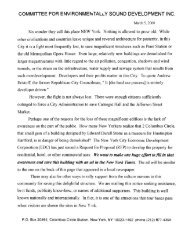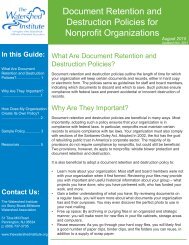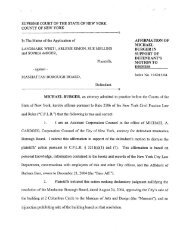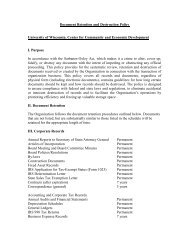Save the Date! - The New York Preservation Archive Project
Save the Date! - The New York Preservation Archive Project
Save the Date! - The New York Preservation Archive Project
You also want an ePaper? Increase the reach of your titles
YUMPU automatically turns print PDFs into web optimized ePapers that Google loves.
Wood moderates HDC’s Fortieth Anniversary panel, including (from left) Barwick, Gruen, Nowvé, and Binger; Courtesy of HDC<br />
Chairman’s Column:<br />
Time Flies: Ten Easy Ways to Remember<br />
By Anthony C. Wood, Founder & Chair<br />
As part of <strong>the</strong> gala celebration of <strong>the</strong> Historic<br />
Districts Council’s Fortieth Anniversary, <strong>the</strong><br />
<strong>Archive</strong> <strong>Project</strong> co-sponsored with HDC<br />
a program capturing <strong>the</strong> story of HDC’s<br />
founding. Fortunately, several of <strong>the</strong> individuals<br />
present at its birth were on <strong>the</strong> program to<br />
share <strong>the</strong>ir memories. With such interest in <strong>the</strong><br />
history of HDC, I excavated my old files and<br />
discovered in draft form a brief history of <strong>the</strong><br />
organization written in 1991 by Joe Rosenberg,<br />
former Chair of HDC. I called Joe to try and<br />
learn more about <strong>the</strong> origins of this document.<br />
Although both of us were active with HDC in<br />
<strong>the</strong> early 1990s, nei<strong>the</strong>r of us could remember<br />
why that history was written (perhaps for<br />
<strong>the</strong>ir Twentieth Anniversary?) and Joe had no<br />
recollection of writing it. Fortunately his name<br />
was on <strong>the</strong> document.<br />
Time truly flies when one is doing preservation!<br />
Before you realize it, you’ve been involved with<br />
a preservation organization for a decade, <strong>the</strong>n<br />
two, and for some, even longer! All of those<br />
things we didn’t write down at <strong>the</strong> time—<br />
ei<strong>the</strong>r because <strong>the</strong>y were fresh in our mind or<br />
because <strong>the</strong>y were current events and we felt<br />
that we didn’t need to record <strong>the</strong>m—suddenly<br />
become foggy memories of what have now<br />
become historic events.<br />
Because demolition is <strong>the</strong> ultimate deadline,<br />
money and time are in short supply, and our<br />
natural instinct is to preserve <strong>the</strong> history that was<br />
made by o<strong>the</strong>rs, not <strong>the</strong> history we are making<br />
ourselves. <strong>Preservation</strong>ists are notoriously<br />
bad when it comes to documenting <strong>the</strong>ir own<br />
stories. Despite o<strong>the</strong>r pressing demands on<br />
our time and limited resources, <strong>the</strong>re are a<br />
number of basic things that preservationists<br />
and preservation organizations can do to<br />
better document <strong>the</strong>ir history—as <strong>the</strong>y make<br />
it! None of <strong>the</strong>se tips are brain surgery, yet it<br />
is surprising how often we don’t think to do<br />
<strong>the</strong>m. Here are ten easy things you can do to<br />
advance <strong>the</strong> cause of preserving preservation’s<br />
history:<br />
1) Fully identify any material (printed or<br />
o<strong>the</strong>rwise) that you generate. Make sure to<br />
include <strong>the</strong> name of <strong>the</strong> organization, <strong>the</strong><br />
date, and where appropriate, <strong>the</strong> name of <strong>the</strong><br />
author.<br />
2) Photo-document every event/activity, and<br />
immediately date and identify <strong>the</strong> event and <strong>the</strong><br />
individuals in each image. Because it is now so<br />
easy and inexpensive, consider videotaping in<br />
addition to still photography.<br />
3) Be diligent in keeping minutes of official<br />
meetings, filing <strong>the</strong>m toge<strong>the</strong>r in one place,<br />
and storing <strong>the</strong>m in a safe location (physical<br />
or virtual).<br />
4) Maintain a master list of all board members<br />
and staff of your organization, denoting terms<br />
of <strong>the</strong>ir service; also try to keep updated<br />
contact information.<br />
5) Keep a master chronology of every event<br />
your organization produces.<br />
6) When projects (whe<strong>the</strong>r advocacy or<br />
programmatic) are completed, stop and do<br />
a quick “memo to <strong>the</strong> file” recounting <strong>the</strong><br />
activity, including a chronology.<br />
7) Develop a system that makes your<br />
organization’s files (both physical and<br />
electronic) easily accessible to your colleagues<br />
(present and future).<br />
8) Ensure that your digital material is being<br />
archived. <strong>The</strong> more you communicate virtually,<br />
<strong>the</strong> more care you must take to keep a historic<br />
record of what you have generated. Hard<br />
copies may still be <strong>the</strong> best way to preserve<br />
blogs and websites over time.<br />
9) Be sure to save interesting preservation<br />
ephemera (buttons from campaigns, flyers,<br />
etc.), properly identify <strong>the</strong>se items, and be sure<br />
to keep <strong>the</strong>m in a safe place (out of floodable<br />
basements, etc.).<br />
10) Inculcate in any preservation organization<br />
with which you are involved an “archival”<br />
mindset so that its organizational culture<br />
becomes one of preserving its own history.<br />
This includes reaching out to anyone in your<br />
organization who has or may have a cache of<br />
preservation papers at risk in a basement office<br />
(or o<strong>the</strong>r perilous location) to work with <strong>the</strong>m<br />
to properly secure those papers now as well as<br />
plan a permanent home to secure <strong>the</strong>ir future.<br />
None of <strong>the</strong> above activities will break <strong>the</strong> bank<br />
or require a full-time staff person. What <strong>the</strong>y<br />
do require are changes in how preservationists<br />
think and act. <strong>The</strong>y challenge us to recognize<br />
that <strong>the</strong> work we are undertaking today is going<br />
to be of interest to <strong>the</strong> preservationists who<br />
come after us. <strong>Preservation</strong> as a movement<br />
needs to have a healthy-enough ego to<br />
appreciate that its history is just as important<br />
as <strong>the</strong> history of <strong>the</strong> individuals, organizations,<br />
social movements, and events that we all work<br />
so hard to document, preserve, and celebrate.<br />
If we don’t preserve preservation’s history,<br />
who will?<br />
Page 2







